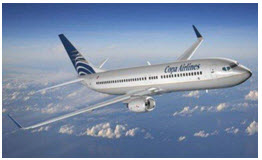The growth in Latin America is mirrored by the growth of the regions airlines from Copa which is our airline in Panama to LATAM Airlines that became the world’s largest airline last week. Here is a Wall Street Journal article covering the subject.
Commentary: Latin American airlines offer good investment opportunities
MIAMI (MarketWatch) — I just touched down in Miami after a 3.5-hour flight from Bogota, Colombia, on American Airlines.
Thumbing through the in-flight magazine, I came across a letter from American Airlines CEO Thomas Horton touting American’s new service to Manaus, Brazil. “Manaus is the seventh American Airlines destination in Brazil,” he says, and brings the number of weekly flights between the U.S. and Brazil to nearly 90.
It’s hard not to boast about Brazil’s economic growth, and its future. After all, it is hosting soccer’s FIFA World Cup in 2014 and the 2016 Summer Olympics in Rio de Janeiro. Although its growth has slowed lately from a pace of 7% in 2010, its economy is still expected to grow 4% this year. More important, the World Cup and the Olympics are expected to bring a hoard of new tourists to South America — and more revenue to airlines.
Investors will also have more to choose from in terms of Latin American airlines.
LATAM becomes world’s biggest airline
Those choices got a big boost this week when LAN Airlines of Chile acquired TAM of Brazil, to create LATAM Airlines LFL -0.63% . With an estimated market capitalization of $13 billion, LATAM becomes the largest airline in the world, beating Air China which is second at $10.7 billion, and Delta Air Lines in third.
LATAM shares were to begin trading in Santiago, São Paulo and the New York Stock Exchange. However, the merger has taken almost two years to complete. As a result, any opportunities from the deal have been exploited by merger arbitragers. Now, investors have the fundamentals of the newly merged airline and the growth of the region to look forward to.
As far as fundamentals go, LATAM is taking on a lot of debt — about $12 billion, most of it from TAM, so it could lose its investment-grade status. But overall, LAN Chile is a well-run airline so look for cost advantages spilling over onto the TAM side. Also, there is only an overlap of 3% on routes between LAN and TAM, which could position the airline well going forward.
The Latin America region as a whole is expected to grow at least 5% a year over the next 10 years, and air travel in the region is expected to exceed that. Latin America’s economy is expected to create a tripling of the region’s air traffic during the next 20 years, making Latin America the second-highest region for growth in air travel in the world, next to the Middle East — according to the Airbus Global Market Forecast. Growth in the middle class of Latin America has fueled the increase, according to the Airbus report.
Travel to-and-from Latin America will be only a small part of the growth. Much of it will be from travel within the region. Where does the middle class of Brazil go for vacation? How about Chile to ski. About 50% of the guests at Vale Nevada, Chile’s biggest ski resort, are Chileans. The rest are foreigners, and 70% of those are Brazilians, with Americans making up just 20% and the rest from other countries.
Opportunities for investors
There are several smaller airlines in Latin America vying for the number-two spot and which could capitalize on the region’s growth and offer investment opportunities for foreign investors.
AviancaTaca Holdings CO:PFAVTA -2.26% , which was created in 2010 from the merger of Avianca of Colombia and TACA of El Salvador, is the strongest contender. Following that are Aeromexico SA, Brazil’s Gol Linhas Aereas Inteltigentes SA GOL -3.09% BR:GOLL4 -3.28% , and COPA of Panama CPA -0.53% .
If investors are looking for a good, safe airline to invest in, COPA probably stands out from the pack. Copa has had double-digit profit growth each year since 2002, and has an annualized dividend yield of about 2.5%, the highest in the region.
But investors might also look to Delta’s purchase of another 4% in Aeromexico as a sign of stability and positioning the airline for future growth.
Investors also shouldn’t count GOL out due to its recent headlines on route reductions and employee layoffs. GOL, in my opinion, simply got ahead of itself in trying to position itself for future growth. But reality set in, and its recent news is an indication that the airline has become more conscious about its spending. Getting rid of its chief executive last week and replacing him with Paulo Kakinoff, Audi AG’s Brazil head, was probably a good move.
Both GOL and Aeromexico were trading recently around their 52-week lows, while COPA was trading substantially above that.
Overall though, it’s a good time to be a Latin American airline — and that means more mergers and acquisitions could be in store.
